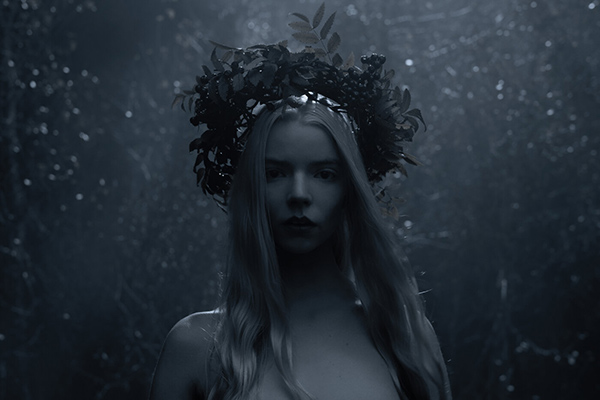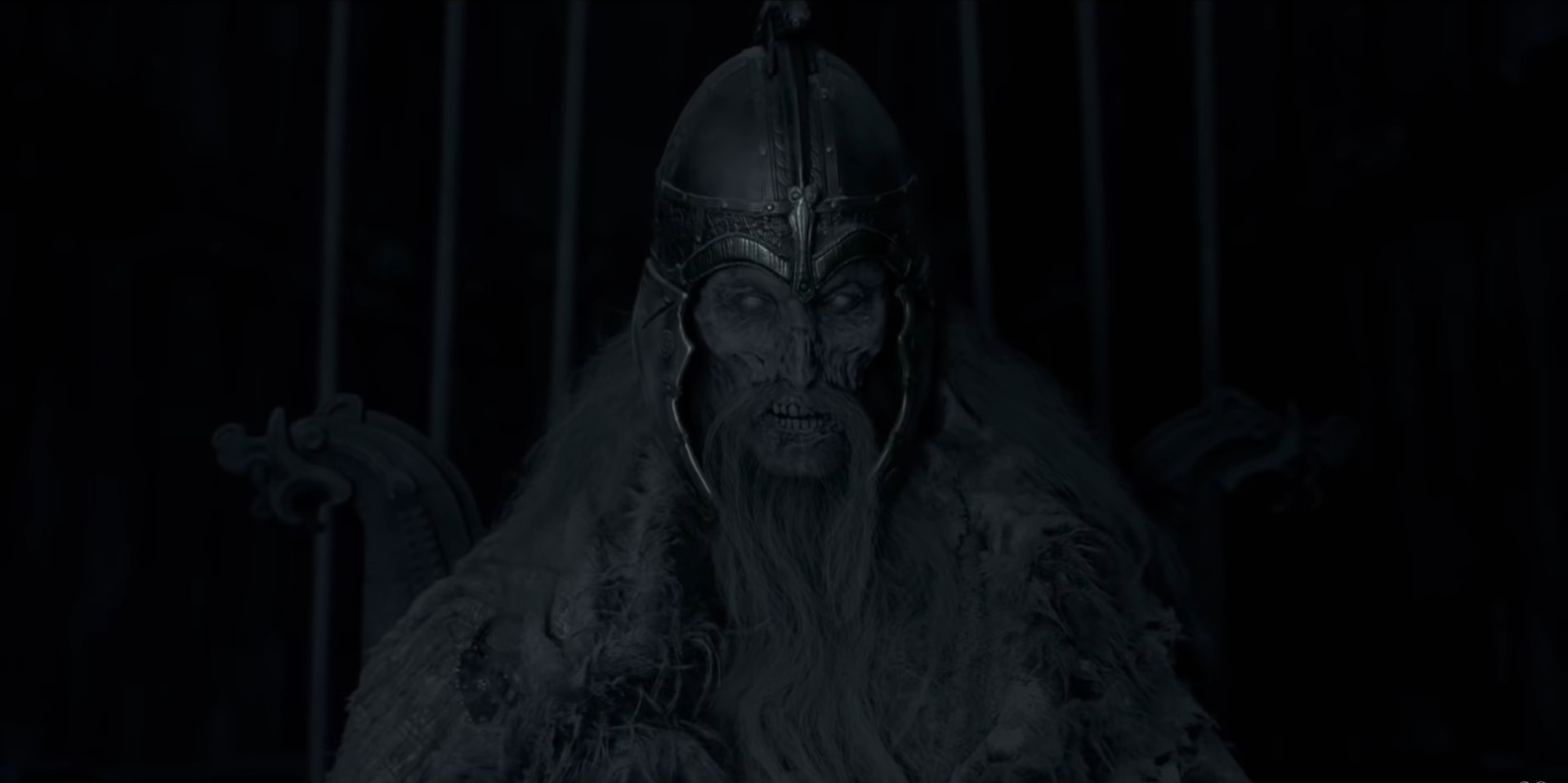NorsePlay Reviews: The Northman.
The question we're confronted with is: Is The Northman the best Viking visual media yet made?
Despite all the previous internet objections (for whatever that noise is worth), the bar for this is History Channel's inarguably successful Vikings (2013-2020 CE). Director Robert Eggers mixes the supernatural moments of magical realism from Vikings with the pastoral setting from Prince Of Jutland (1994 CE), while screenwriter Sjón pulls from the Icelandic tropes of When the Raven Flies (1984 CE), using Saxo Grammaticus' Amleth legend from Gesta Danorum: Deeds of the Danes as a baseline point and The Sagas of Icelanders as building blocks, all which make for a necessarily brutal & beautiful film.
 |
| [model Ineta Sliuzaite rages through the sky as a valkyrie with her line-filed teeth!] |
[Note: Spoilers are about to occur ... but you read Hamlet in high school like everyone else, right?]
For Heathens coming to this film, there's soooo much to love, most especially when the Valkyrja rides in to take Amleth skyward to Valhöll. One can't help but feel a rush of transcendent joy as you identify, and are given a much needed image.
While the film starts in Norway and moves to Russia, the majority then takes place in Iceland, which is where the screenplay diverges from Saxo as his traitorous uncle Fjölnir loses his usurped kingdom to unifier Harald Fairhair, and relocates to become a well-off farmer in settlement-era Iceland. This scales down what the movie needs in terms of filming resources, which also makes it the lighter cast that Eggers is mostly used to managing as per The Witch or The Lighthouse.
In terms of depicting Arch-Heathenry, there's a lot brought to life by the cinematographer's flickering torchlight. The filmmakers hired University of Uppsala's noted archeologist Neil Price, University of Iceland's folkloristics professor Terry Gunnell, and accomplished researcher Jóhanna Katrin Friðriksdóttir as consultants so that both the literature & artifacts were mainly respected in terms of what we think we know.
There were some awesome Berserker/Ulfhednar sequences, the first as Amleth's initiation to manhood ritual, then with the Rus so they can raise martial morale the night before a raid to become a properly bonded warband. In that first we get Willem Dafoe as a jester-hooded court fool (which if we look at character functions in Beowulf, the disrespectful & taunting Unferð mirrors this), who then wears another mask as the high priest who leads Amleth's initiation, which is pretty Odinic since neither aspect of Dafoe's Heimir the Fool is truly who he is, both being only disguises.
As an amazing detail in the temple, one can see the rectangles of the little gold gullgubber nailed into the structure's wooden columns, and more scattered along the floor of the subterranean initiation den. It's a throwaway set dressing thing, and the camera never even closes in to reveal the that these tiny golden foils are stamped with beautiful miniature images, but if you know your archaeology, just spotting their inclusion's a delight, and seeing the use of them possibly integrated with both high pillars and the reginnaglar holy nails as offerings seems a fitting guess.
As the story progresses, a cultic subtext of Amleth's patron Odin versus Fjölnir's patron Freyr emerges, and even a line where Amleth baits Fjölnir that Odin will defeat his "God of Erections". The sagas do sometimes have opposing characters backed by allied Gods, and while Odin & Freyr are on the same divine team, it's interesting to see parties invoking them against each other (and if one wanted to NorsePlay this, it's not completely out of the question that perhaps Odin and Freyr could've literally opposed each other during the Æsir-Vanir War).
There's some very stylized speech & dialogue, which to a modern audience might seem stilted, but not only do these touches of poetry call to Shakepeare's wordplay, but moreso feel like the conventions of prosimetrum in the Norse Sagas where regular text drops and characters actually speak in poetic forms for emphasis to praise, flatter, slander, or mourn.
At a certain point, Amleth is directed to obtain a magic dwarven-forged sword, Draugr, which can only be drawn at night, and is guarded by its namesake, an undead tomb-dwelling Draugr.
The casting of lead Alexander Skarsgård, given his breakout role from HBO's True Blood (2008-2014 CE) as vampire Eric Northman, only makes sense as he's already done the homework, and that experiential background only gets more meta given that he has to fight a Norse undead.
With less Björk than anticipated, she only gets to put in a cameo, albeit a powerful one that sets the prophecy for the film's plot, and while she speaks Amleth's fate, she literally spins woolen thread using her distaff and spindle whorl.
 |
| [Anya Taylor-Joy as Olga of the Birch Forest!] |
As for the other female leads, they also don't get enough screentime. The preview for Anya Taylor-Joy's voiceover & depiction of Olga of the Birch Forest as a magical aggressor is an overstatement for what actually gets onscreen.
Kidman's Gudrún is also underused, though the time she gets surprisingly flips the traditional Shakespearean Gertrude motivations on their ear, which makes her much more interesting. When Kidman whispers to Fjolnir "let me be the whetstone of your strength", it's straight out of the Sagas' strong medieval Icelandic wives stoking the men of their households into action, whether for good or ill. For home release I'd hope that maybe we get deleted scenes of the leading women, or perhaps an extended cut with more of them included.
The Northman also explores the spectrum of Amleth's being a raider and then an enslaved thrall, showing both sides of that coin.
Knattleikr, the Icelandic mashup sport between rugby and lacrosse, gets featured in a particularly rough sequence, and its gladiatorial meanness is amazing to watch.
There's probably a media arts thesis left to unpack from The Northman but NorsePlay wanted to instead mostly hit the important religious & historical notes for the viewer of this exceptional film.
So, is it better than Vikings? Scopewise it isn't; there's more real estate covered in Vikings, more narrative spread just by the format of having six seasons to explore versus The Northman's 2 hours and 15 minutes. What I would like to praise is that it seems to have a slight edge over Valhalla Rising (2009 CE) in terms of pacing and its brutal tonality, and by adding even more metaphysics on the viewer's plate. I'm also going to say I still prefer The 13th Warrior (1999 CE) over The Northman, which is more action-adventure over this offering's sterner dramatic tragedy, but that's also subgenre apples & oranges.
Comparatives & rankings aside, The Northman is definitely worth watching, and will historically prove to be a top tier Viking cinema choice. Go see it and leave me your thoughts in the comments below, NorsePlayers!
Guillermo Maytorena IV knew there was something special in the Norse Lore when he picked up a copy of the d'Aulaires' Norse Gods and Giants at age seven. Since then he's been fascinated by the truthful potency of Norse Mythology, passionately read & studied, embraced Ásatrú, launched the Map of Midgard project, and spearheaded the neologism/brand NorsePlay. If you have employment/opportunities in investigative mythology, field research, or product development to offer, do contact him.



Comments
Post a Comment